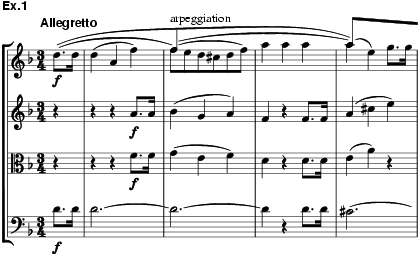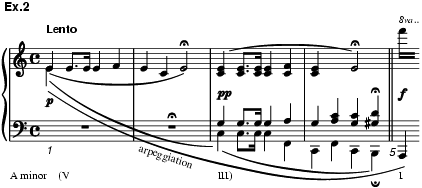
(Ger. Brechung).
In Schenkerian analysis (see Analysis, §II, 4), the movement of the bass from the root of the tonic to its fifth (the dominant) and back again as an encapsulation of the basic harmonic plan of a piece; the lower part of the Ursatz. Also a method of Prolongation by which any part is elaborated in the form of a broken chord. In both cases, a vertical configuration (an interval or a chord) is made linear or ‘horizontalized’ (Ger. horizontalisiert). The arpeggiation of the bass I–V–I, which Schenker specifically referred to as Bassbrechung, brings the tonic chord to life, and represents the three elements essential for a piece to have tonal shape: establishment of tonic, move to a dominant preparation, return of the tonic. Its fundamental importance in this respect led Schenker to give it the epithet of ‘the sacred triangle’ (Der freie Satz, 1935 §19).
As a method of prolongation, arpeggiation is used frequently in the service of a structurally important note in the upper voice; for example, in the Minuet from Mozart's String Quartet in D minor k421/417b the first violin part rises from d'' through f'' to a'' (as indicated by the slurs in ex.1); a'' is also the first note of a linear progression (Zug (i)) through a fifth, a''–g''–f''–e''–d'', in bars 3–10.

Arpeggiation may similarly be used to serve a harmony of structural importance (Stufe), as illustrated by the arpeggiation e'–c–A at the opening of Chopin's Etude in A minor op.25 no.11 (ex.2; after Der freie Satz, fig.100/3c). Sometimes an arpeggiation appears in conjunction with another method of prolongation (especially Reaching over), and often it effects an ascending or descending Register transfer.

It
is not necessary for the arpeggiated chord to be a triad; Schenker illustrated
the use of arpeggiation of a diminished chord at the start of Chopin's
‘Revolutionary Etude’, in his Fünf Urlinie-Tafeln (1932); for a
reproduction of these graphs, see Analysis, fig.20. Nor does it have to be modally
‘pure’ at a middleground level: in his analysis of Auf dem Flusse from
Schubert's Winterreise (Der freie Satz, fig.40/2), the first note
of the fundamental upper voice (Urlinie) is approached by the arpeggiation e'–g![]() '–b'–e''–g
'–b'–e''–g![]() ''.
''.
WILLIAM DRABKIN